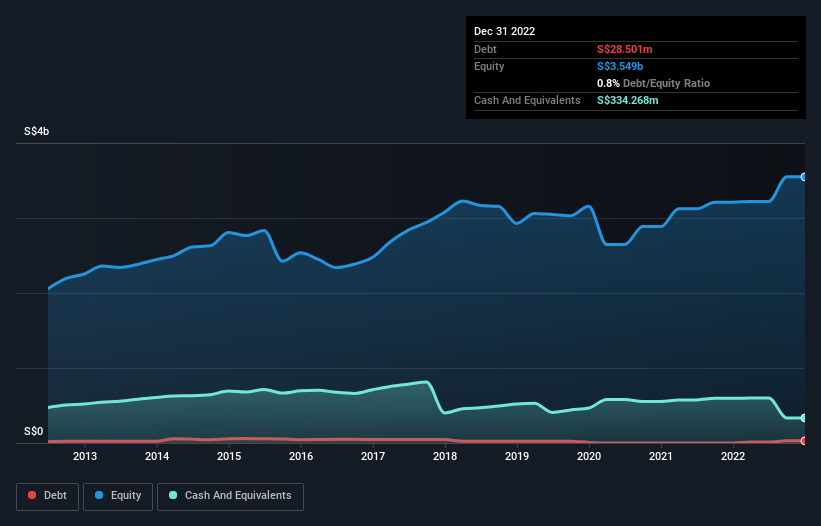Howard Marks put it nicely when he said that, rather than worrying about share price volatility, 'The possibility of permanent loss is the risk I worry about... and every practical investor I know worries about.' So it might be obvious that you need to consider debt, when you think about how risky any given stock is, because too much debt can sink a company. We can see that Haw Par Corporation Limited (SGX:H02) does use debt in its business. But is this debt a concern to shareholders?
What Risk Does Debt Bring?
Generally speaking, debt only becomes a real problem when a company can't easily pay it off, either by raising capital or with its own cash flow. Ultimately, if the company can't fulfill its legal obligations to repay debt, shareholders could walk away with nothing. However, a more common (but still painful) scenario is that it has to raise new equity capital at a low price, thus permanently diluting shareholders. Of course, plenty of companies use debt to fund growth, without any negative consequences. The first thing to do when considering how much debt a business uses is to look at its cash and debt together.
Check out our latest analysis for Haw Par
How Much Debt Does Haw Par Carry?
You can click the graphic below for the historical numbers, but it shows that as of December 2022 Haw Par had S$28.5m of debt, an increase on none, over one year. But on the other hand it also has S$334.3m in cash, leading to a S$305.8m net cash position.

How Strong Is Haw Par's Balance Sheet?
According to the last reported balance sheet, Haw Par had liabilities of S$100.5m due within 12 months, and liabilities of S$912.0k due beyond 12 months. On the other hand, it had cash of S$334.3m and S$27.1m worth of receivables due within a year. So it can boast S$259.9m more liquid assets than total liabilities.
This surplus suggests that Haw Par has a conservative balance sheet, and could probably eliminate its debt without much difficulty. Succinctly put, Haw Par boasts net cash, so it's fair to say it does not have a heavy debt load!
On top of that, Haw Par grew its EBIT by 76% over the last twelve months, and that growth will make it easier to handle its debt. There's no doubt that we learn most about debt from the balance sheet. But you can't view debt in total isolation; since Haw Par will need earnings to service that debt. So if you're keen to discover more about its earnings, it might be worth checking out this graph of its long term earnings trend.
But our final consideration is also important, because a company cannot pay debt with paper profits; it needs cold hard cash. While Haw Par has net cash on its balance sheet, it's still worth taking a look at its ability to convert earnings before interest and tax (EBIT) to free cash flow, to help us understand how quickly it is building (or eroding) that cash balance. During the last three years, Haw Par produced sturdy free cash flow equating to 65% of its EBIT, about what we'd expect. This free cash flow puts the company in a good position to pay down debt, when appropriate.
Summing Up
While it is always sensible to investigate a company's debt, in this case Haw Par has S$305.8m in net cash and a decent-looking balance sheet. And we liked the look of last year's 76% year-on-year EBIT growth. So is Haw Par's debt a risk? It doesn't seem so to us. The balance sheet is clearly the area to focus on when you are analysing debt. However, not all investment risk resides within the balance sheet - far from it. For instance, we've identified 2 warning signs for Haw Par (1 is potentially serious) you should be aware of.
If you're interested in investing in businesses that can grow profits without the burden of debt, then check out this free list of growing businesses that have net cash on the balance sheet.
Valuation is complex, but we're here to simplify it.
Discover if Haw Par might be undervalued or overvalued with our detailed analysis, featuring fair value estimates, potential risks, dividends, insider trades, and its financial condition.
Access Free AnalysisHave feedback on this article? Concerned about the content? Get in touch with us directly. Alternatively, email editorial-team (at) simplywallst.com.
This article by Simply Wall St is general in nature. We provide commentary based on historical data and analyst forecasts only using an unbiased methodology and our articles are not intended to be financial advice. It does not constitute a recommendation to buy or sell any stock, and does not take account of your objectives, or your financial situation. We aim to bring you long-term focused analysis driven by fundamental data. Note that our analysis may not factor in the latest price-sensitive company announcements or qualitative material. Simply Wall St has no position in any stocks mentioned.
About SGX:H02
Haw Par
Manufactures, markets, and trades in healthcare products in Singapore, The Association of Southeast Asian Nations countries, other Asian countries, and internationally.
Excellent balance sheet with proven track record.
Market Insights
Community Narratives




